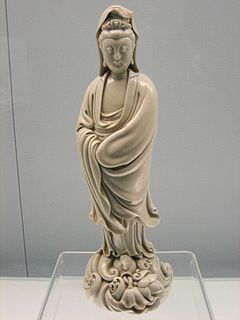 W
WA figurine or statuette is a small, three-dimensional sculpture that represents a human, deity or animal, or, in practice, a pair or small group of them. Figurines have been made in many media, with clay, metal, wood, glass, and today plastic or resin the most significant. Ceramic figurines not made of porcelain are called terracottas in historical contexts.
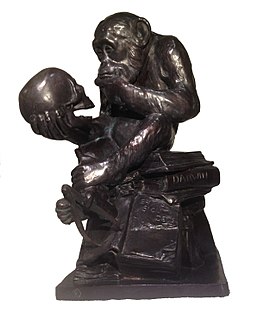 W
WThe Affe mit Schädel is a famous work by the late-19th-century German sculptor Hugo Rheinhold. The statuette is otherwise known as the Affe, einen Schädel betrachtend. It was first exhibited in 1893 at the Große Berliner Kunstaustellung.
 W
WAnimal figurines are figurines that represent animals, either as decorative pieces, toys or collectibles. They are often made of plastic, ceramics, or metal.
 W
WThis is a list of Royal Doulton Bunnykins figurines. Doulton & Co. introduced the Bunnykins figurines in 1939 with six original Bunnykins figurines designed by Charles Noke based on illustrations by Sister Mary Barbara Bailey. Shortly thereafter, and prior to World War II, Doulton & Co. discontinued their manufacture. After Royal Doulton purchased the Beswick Pottery factory in 1969, Royal Doulton reintroduced the Bunnykins figurines. After the closure of Royal Doulton factory in England in 2005, Bunnykins figurines are produced in Asia. The Bunnykins figurines are in ascending order and include the name of the figurine, designer/modeler, date introduced, and the date discontinued.
 W
WThe Byblos figurines or Phoenician statuettes are approximately 1,500–2,000 ex-voto statuettes found in ancient Phoenician temples in Lebanon, primarily in Byblos, but also in Kamid al lawz. The statuettes date to the second millennium BC and are made of bronze, silver, or copper alloy. The Byblos figurines are considered to represent the best example of their kind across the Levant.
 W
WClarecraft was a company which produced fantasy figurines. Its most popular series was an officially licensed series of figurines based on the Discworld novels by Terry Pratchett. The company was founded in 1980 by Bernard and Isobel Pearson, and acquired the rights to make Discworld figurines in 1990. In 1993, Clarecraft was purchased by Sally Couch and Trish Baker. It is one of the few large scale vendors of Discworld merchandise, along with Stephen Briggs, Paul Kidby, and the Discworld Emporium.
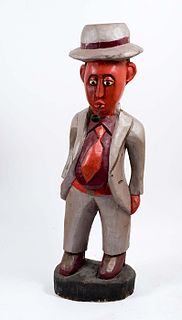 W
WColon statues, a term derived from the French statues colon, are a genre of wooden figurative sculpture within African art which originated during the colonial period. The statues commonly depict European colonial officials such as civil servants, doctors, soldiers or technicians or Europeanised middle-class Africans. They are often characterised by recurrent decorative motifs, such as pith helmets, suits, official uniforms or tobacco pipes, and are painted in bright or glossy colours with vegetable-based paints.
 W
WThe Dagenham idol is a wooden statue of a naked human figure, found in Dagenham in 1922. The statue has been carbon dated to around 2250 BC, during the late Neolithic period or early Bronze Age, making it one of the oldest human representations found in Europe.
 W
WA Daruma doll is a hollow, round, Japanese traditional doll modeled after Bodhidharma, the founder of the Zen tradition of Buddhism. These dolls, though typically red and depicting a bearded man (Bodhidharma), vary greatly in color and design depending on region and artist. Though considered a toy by some, Daruma has a design that is rich in symbolism and is regarded more as a talisman of good luck to the Japanese. Daruma dolls are seen as a symbol of perseverance and good luck, making them a popular gift of encouragement. The doll has also been commercialized by many Buddhist temples to use alongside the setting of goals.
 W
WThe word diorama can either refer to a 19th-century mobile theatre device, or, in modern usage, a three-dimensional full-size or miniature model, sometimes enclosed in a glass showcase for a museum. Dioramas are often built by hobbyists as part of related hobbies such as military vehicle modeling, miniature figure modeling, or aircraft modeling.
 W
WStaffordshire dog figurines are matching pairs of pottery spaniel dogs, standing guard, which were habitually placed on mantelpieces in 19th-century homes. Mainly manufactured in Staffordshire pottery, these earthenware figures were also made in other English counties and in Scotland. They are also known as hearth spaniels or fireplace dogs as they were positioned on top of the mantelpiece. Many other breeds were produced, particularly the greyhound, though the spaniels were especially popular and this is attributed to royalty favouring the King Charles Spaniel breed. In Scotland, they were colloquially termed Wally dugs and were manufactured in bulk at potteries in places such as Pollokshaws in Glasgow and Portobello near Edinburgh.
 W
WThe Dumbarton Oaks birthing figure is a possibly Aztec scapolite figurine of a woman giving childbirth in a squatting position. Housed in the Dumbarton Oaks collection, United States, the figurine is considered by several scholars to be a pre-Columbian artwork, while others believe it was made in modern times, possibly in the 19th century. The figurine measures 20.2 cm in height.
 W
WFoundation figures were ritualistic works of art from the Early Dynastic period that were used in the construction of ancient Mesopotamian temples. Foundation pegs first appeared in ancient Sumer around the third millennium BCE. Stylized as anthropomorphic nails, foundation figures were symbolically used to mark the grounds of a temple. These nails/pegs were either hammered around the foundation of the temple, along with an inscribed tablet, or they were buried in clay boxes under the foundation of the temple. Typically, the pegs were created to represent either the deity that the temple was honoring, or the king that orchestrated the construction of the temple. Many of the pegs discovered stand about a foot tall and show a clear attention to detail. It is believed that foundation figures were used for solely ritualistic purposes. This is because they were not meant to be seen by the public, yet still show a high level of detail and aesthetic thought.
 W
WGarden gnomes are lawn ornament figurines of small humanoid creatures known as gnomes. Traditionally, the figurines depict male dwarfs wearing red pointy hats. Typically, gnomes stand between one and two feet. A recent trend has introduced miniature gnomes of only a few inches in height. Originating as a decoration for the wealthy in Europe, garden gnomes are now prevalent in gardens and lawns throughout the Western world, among all social classes, and often regarded as kitsch.
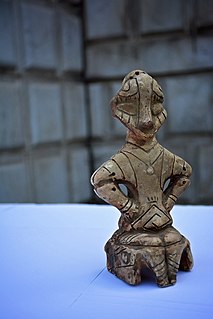 W
WGoddess on the Throne is a terracotta figurine found at the site of the Tjerrtorja spinning mill in Pristina, the capital city of Kosovo, in 1956. The seated terracotta figure is a well-preserved specimen of small Neolithic plastic Vinča culture. It measures 18.5 cm high and is dated to 5700–4500 BC.
 W
WTerracotta figurines are a mode of artistic and religious expression frequently found in ancient Greece. These figurines abound and provide an invaluable testimony to the everyday life and religion of the ancient Greeks. The so-called Tanagra figurines, in fact made elsewhere as well, are one of the most important types.
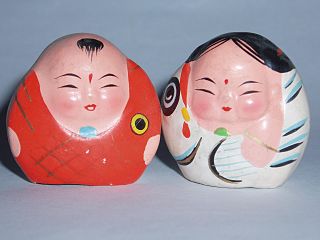 W
WHuishan clay figurine is a traditional Chinese folk art in Wuxi, Jiangsu Province, China, with a history of more than 400 years. The production of Wuxi Huishan clay figurines began at the end of the Ming Dynasty and developed in the Qing Dynasty with specialized Huishan clay craftsmanship workshops. On May 20, 2006, Huishan clay figurine was added to the first batch of National intangible cultural heritage lists with the approval of the State Council of the People's Republic of China.
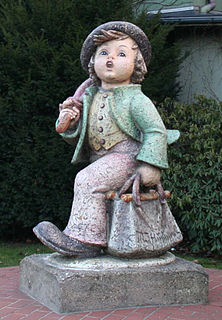 W
WHummel figurines are a series of porcelain figurines based on the drawings of Sister Maria Innocentia Hummel, O.S.F.
 W
WThe Jew with a coin is a good luck charm in Poland, where images or figurines of the character, usually accompanied by a proverb, are said to bring good fortune, particularly financially. For most Poles the figurines represent a harmless superstition and a positive, sympathetic portrayal of Jewishness. The motif was first described in articles from 2000, and probably dates back to the early 1990s. While widely recognized the figurines are not the most popular good luck charm in Poland.
 W
WThe Jim Crow Museum of Racist Memorabilia at Ferris State University, Big Rapids, Michigan, displays a wide variety of everyday artifacts depicting the history of racist portrayals of African Americans in American popular culture. The mission of the Jim Crow Museum is to use objects of intolerance to teach tolerance and promote social justice.
 W
WKkoktu are Korean funerary figures that protect, serve and care for the deceased in the immediate afterlife. They come in a procession that comprises a leading Guardian figure, followed by a Caregiver and an Entertainer. Figures of Dragons and Phoenixes are also common as symbols of freedom and regeneration.
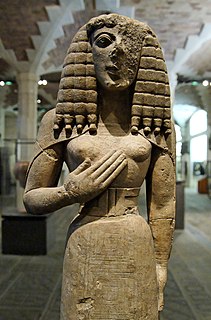 W
WThe relatively small limestone Cretan sculpture called the Lady of Auxerre, at the Louvre Museum in Paris depicts an archaic Greek goddess of c. 650 - 625 BCE. It is a Kore ("maiden"), perhaps a votary rather than the maiden Goddess Persephone herself, for her right hand touches her solar plexus and her left remains stiffly at her side. It is also possible that the Kore is a depiction of a deceased individual, possibly in a position of prayer.
 W
WLady of Galera is an alabaster female figurine, made in the 7th century BC, that probably represents the Near Eastern goddess Astarte. It is at the National Archaeological Museum of Spain, in Madrid.
 W
WThe Löwenmensch figurine, also called the Lion-man or the Lion-human of Hohlenstein-Stadel, is a prehistoric ivory sculpture discovered in Hohlenstein-Stadel, a German cave in 1939. The German name, Löwenmensch, meaning "lion-person" or "lion-human", is used most frequently because it was discovered and is exhibited in Germany.
 W
WA magot is a seated oriental figurine, usually of porcelain or ivory, of a grotesque form; the name derives from the Barbary ape, also known as "magot".
 W
WThe maneki-neko is a common Japanese figurine which is often believed to bring good luck to the owner. In modern times, they are usually made of ceramic or plastic. The figurine depicts a cat, traditionally a calico Japanese Bobtail, with a paw raised in a Japanese beckoning gesture. The figurines are often displayed in shops, restaurants, pachinko parlors, dry cleaners, laundromats, bars, casinos, hotels, nightclubs, and other businesses, generally near the entrance. Some maneki-neko are equipped with a mechanical paw which slowly moves back and forth.
 W
WIn miniature wargaming, players enact simulated battles using scale models called miniature models, which can be anywhere from 2 mm to 54 mm in height, to represent warriors, vehicles, artillery, buildings, and terrain. These models are colloquially referred to as miniatures or minis.
 W
WMississippian culture pottery is the ceramic tradition of the Mississippian culture found as artifacts in archaeological sites in the American Midwest and Southeast. It is often characterized by the adoption and use of riverine shell-tempering agents in the clay paste. Shell tempering is one of the hallmarks of Mississippian cultural practices. Analysis of local differences in materials, techniques, forms, and designs is a primary means for archaeologists to learn about the lifeways, religious practices, trade, and interaction among Mississippian peoples. The value of this pottery on the illegal antiquities market has led to extensive looting of sites.
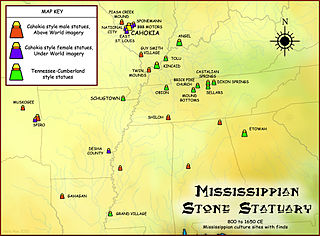 W
WThe Mississippian stone statuary are artifacts of polished stone in the shape of human figurines made by members of the Mississippian culture and found in archaeological sites in the American Midwest and Southeast. Two distinct styles exist; the first is a style of carved flint clay found over a wide geographical area but believed to be from the American Bottom area and manufactured at the Cahokia site specifically; the second is a variety of carved and polished locally available stone primarily found in the Tennessee-Cumberland region and northern Georgia. Early European explorers reported seeing stone and wooden statues in native temples, but the first documented modern discovery was made in 1790 in Kentucky, and given as a gift to Thomas Jefferson.
 W
WA model figure is a scale model representing a human, monster or other creature. Human figures may be either a generic figure of a type, a historical personage, or a fictional character.
 W
WThe Muri statuette group is a group of six Gallo-Roman bronze figurines found in 1832 in Muri bei Bern, Switzerland. The group includes representations of the gods Jupiter, Juno, Minerva, Naria, Artio and of a Lar. The ensemble includes the only known representations of Artio and Naria, and is one of the more significant items in the collection of the Historical Museum of Bern.
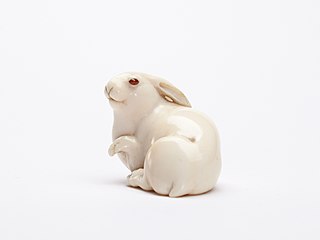 W
WA netsuke is a miniature sculpture, originating in 17th century Japan. Initially a simply-carved button fastener on the cords of an inro box, netsuke later developed into ornately sculpted objects of craftsmanship.
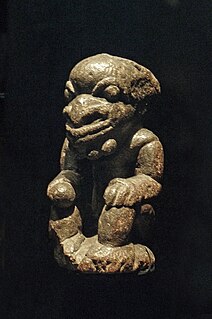 W
WA Nomoli is a carved stone figurine native to Sierra Leone and Liberia. They are usually made of soapstone, limestone or granite.
 W
WNutcracker dolls, also known as Christmas nutcrackers, are decorative nutcracker figurines most commonly made to resemble a toy soldier. In German tradition, the dolls are symbols of good luck, frightening away malevolent spirits. While nearly all nutcrackers from before the first half of the 20th century are functional, a significant proportion of modern nutcrackers are primarily decorative, and not able to crack nuts. Nutcrackers are also a part of German folklore, serving as protectors of a house.
 W
WOkiagari-koboshi or Okiagari-kobōshi is a Japanese traditional doll. The toy is made from papier-mâché and is a roly-poly toy, designed so that its weight causes it to return to an upright position if it is knocked over. Okiagari-kobōshi is considered a good-luck charm and a symbol of perseverance and resilience.
 W
WOlmec figurines are archetypical figurines produced by the Formative Period inhabitants of Mesoamerica. While not all of these figurines were produced in the Olmec heartland, they bear the hallmarks and motifs of Olmec culture. While the extent of Olmec control over the areas beyond their heartland is not yet known, Formative Period figurines with Olmec motifs were widespread in the centuries from 1000 to 500 BC, showing a consistency of style and subject throughout nearly all of Mesoamerica.
 W
WThe pew group is a rare type of pottery Staffordshire figure, apparently made only in the 1740s. Typically it has two or three "rigidly posed" figures sitting on a high-backed bench, often with a woman in the centre; great attention is paid to details of hair and clothing. The setting is not church, as the usual name suggests, but a comfortable home or inn, where high-backed settles were a common piece of furniture. Details are picked out in dark brown or black glaze, and dogs and musical instruments may be depicted, or the gentlemen may be taking snuff.
 W
WPiggy bank is the traditional name of a coin container normally used by children. The piggy bank is known to collectors as a "still bank" as opposed to the "mechanical banks" popular in the early 20th century. These items are also often used by companies for promotional purposes. The use of the name 'piggy bank' gave rise to its widely recognized 'pig' shape, and many financial service companies use piggy banks as logos for their savings products.
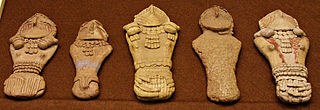 W
WThe Pilling Figurines are a set of eleven clay figurines made by the Fremont culture. They were discovered in 1950 by Clarence Pilling, a Utah rancher, under a rock overhang in a side canyon of Range Creek, Utah. The figurines are believed to be around 1000 years old.
 W
WThe name poppy goddess is often used for a famous example of a distinctive type of large female terracotta figurine in Minoan art, presumably representing a goddess, but not thought to be cult images, rather votive offerings. It was discovered in a sanctuary of the Post-palace period at Gazi, Crete, and is now is in the Heraklion Archaeological Museum.
 W
WRoyal Doulton Bunnykins tableware and figurines are popular ceramic designs manufactured as nursery dishes and collectible figurines. The chinaware line originated with artwork by Sister Mary Barbara Bailey, the daughter of Cuthbert Bailey, general manager of Doulton during the 1930s. Unbeknownst to the public, Mary Barbara Bailey was not a professional illustrator, but a nun in the Augustinian Canonesses of the Lateran. Sister Mary Barbara provided illustrations to the designers of Doulton & Co. to be used on tableware. Six Bunnykins figurines were produced based on Sister Mary Barbara's illustrations in 1939 and were designed by Charles Noke. Discontinued during World War II, Bunnykins figurines were not reintroduced until 1969. Bunnykins continued to be produced in England until 2005. Bunnykins figurines and tableware are currently produced in Asia.
 W
WThis is a list of list of Royal Doulton figurines in ascending order by HN number. HN is named after Harry Nixon (1886–1955), head of the Royal Doulton painting department who joined Doulton in 1900. This list includes the HN number, the title of the Royal Doulton figurine, the designer(s), the date introduced, and if discontinued, the date discontinued.
 W
WSantons are small hand-painted terracotta nativity scene figurines produced in the Provence region of southeastern France. In a traditional Provençal crèche, there are 55 individual figures representing various characters from Provençal village life such as the scissors grinder, the fishwife, the blind man, and the chestnut seller.
 W
WA Snow Baby is a small figurine, usually of a child, that depicts some aspect of the Christmas holidays or of winter sports. The traditional snow baby is made of unglazed biscuit porcelain and shows a child dressed in a snowsuit; the suit itself is covered in small pieces of crushed bisque, giving the appearance of fallen snowflakes. Figurines of other characters were also made, including Santa Claus, elves and animals such as penguins and polar bears.
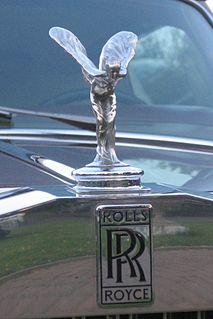 W
WThe Spirit of Ecstasy is the bonnet ornament sculpture on Rolls-Royce cars. It is in the form of a woman leaning forwards with her arms outstretched behind and above her. Billowing cloth runs from her arms to her back, resembling wings.
 W
WStaffordshire figures are a type of popular pottery figurine made in England from the 18th century onward. Most Staffordshire figures made from 1740 to 1900 were produced by small potteries and makers' marks are generally absent. Most Victorian figures were designed to stand on a shelf or mantlepiece and are therefore only modelled and decorated where visible from the front and sides. These are known as 'flatbacks'.
 W
WThe Statuette of God Teisheba is an Urartian bronze statuette made in the 8-7th century BC, found near Teishebaini in 1941, depicting the Araratian (Urartian) god of storms and thunder Teisheba. It is at the History Museum of Armenia, in Yerevan. The statuette was found by Hripsime Janpoladyan who was the wife of the head of expedition Boris Piotrovsky.
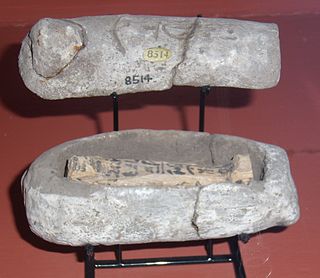 W
WStick shabtis are ancient Egyptian ushabtis made of wood.
 W
WThe Tanagra figurines were a mold-cast type of Greek terracotta figurines produced from the later fourth century BC, named after the Boeotian town of Tanagra, where many were excavated and which has given its name to the whole class. However, they were produced in many cities. They were coated with a liquid white slip before firing and were sometimes painted afterward in naturalistic tints with watercolors, such as the famous "Dame en Bleu" at the Louvre. They were widely exported around the ancient Greek world. Such figures were made in many other Mediterranean sites, including Alexandria, Tarentum in Magna Graecia, Centuripe in Sicily and Myrina in Mysia.
 W
WA Tree of Life is a theme of clay sculpture created in central Mexico, especially in the municipality of Metepec, State of Mexico. The image depicted in these sculptures originally was for the teaching of the Biblical story of creation to natives in the early colonial period. The fashioning of the trees in a clay sculpture began in Izúcar de Matamoros, Puebla but today the craft is most closely identified with Metepec. Traditionally, these sculptures are supposed to consist of certain biblical images, such as Adam and Eve, but recently there have been trees created with themes completely unrelated to the Bible.
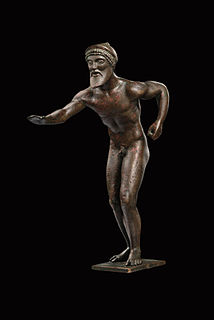 W
WThe Tübingen Hoplitodromos Runner is a statuette of an Ancient Greek athlete wearing a helmet, made in Attica around 485 BC. It is exhibited in the Museum Alte Kulturen of the University of Tübingen. At the end of the 19th century, the characteristic posture of the athlete led Friedrich Hauser to interpret the statuette as an armed hoplitodromos runner in the starting position, an interpretation that is undisputed today.
 W
WThe ushabti was a funerary figurine used in ancient Egyptian funerary practices. The Egyptological term is derived from 𓅱𓈙𓃀𓏏𓏭𓀾 wšbtj, which replaced earlier 𓆷𓍯𓃀𓏏𓏭𓀾 šwbtj, perhaps the nisba of 𓈙𓍯𓃀𓆭 šwꜣb "Persea tree".
 W
WVidovdanka is a Late Mesolithic anthropomorphic figurine made of terracotta regarded as symbol of the Vinča culture, which flourished in prehistoric Serbia in 5500 BC. It was excavated at 6.2 metres (20 ft) deep at Vinča, Serbia on the day of Vidovdan in 1930. It stands 30.7 centimetres (12.1 in) tall.
 W
WA wedding cake topper is a small model that sits on top of a wedding cake, normally a representation of the couple in formal wedding attire.
 W
WWhack & Slaughter is a set of fantasy skirmishing game rules allowing players to play with all kinds of fantasy as well as pirate themed miniatures. It is meant to be played with as few as one miniature per player, allowing more players to play. Most scenarios are meant to be played with up to eight players forming two teams of four players . In addition to a miniature, a player needs a set of five dice as well as a "Hero Card" as a reference for the Hero's abilities.
 W
WWooden tomb models were deposited as grave goods in the tombs and burial shafts in Middle Kingdom of Egypt. They included a wide variety of wooden figurines and scenes, such as boats, granaries, baking and brewing scenes and butchery scenes.
 W
WWrocław’s dwarfs are small figurines that first appeared in the streets of Wrocław, Poland in 2005. Since then, their numbers have been continually growing, and today they are considered a tourist attraction: those who would like to combine sight-seeing in Wrocław with "Hunting for dwarfs" are offered special brochures with a map and mobile application software for smartphones. In April 2019, there were already 600 dwarfs in the city. Six are located outside the city at the LG plant in Biskupice Podgórne.